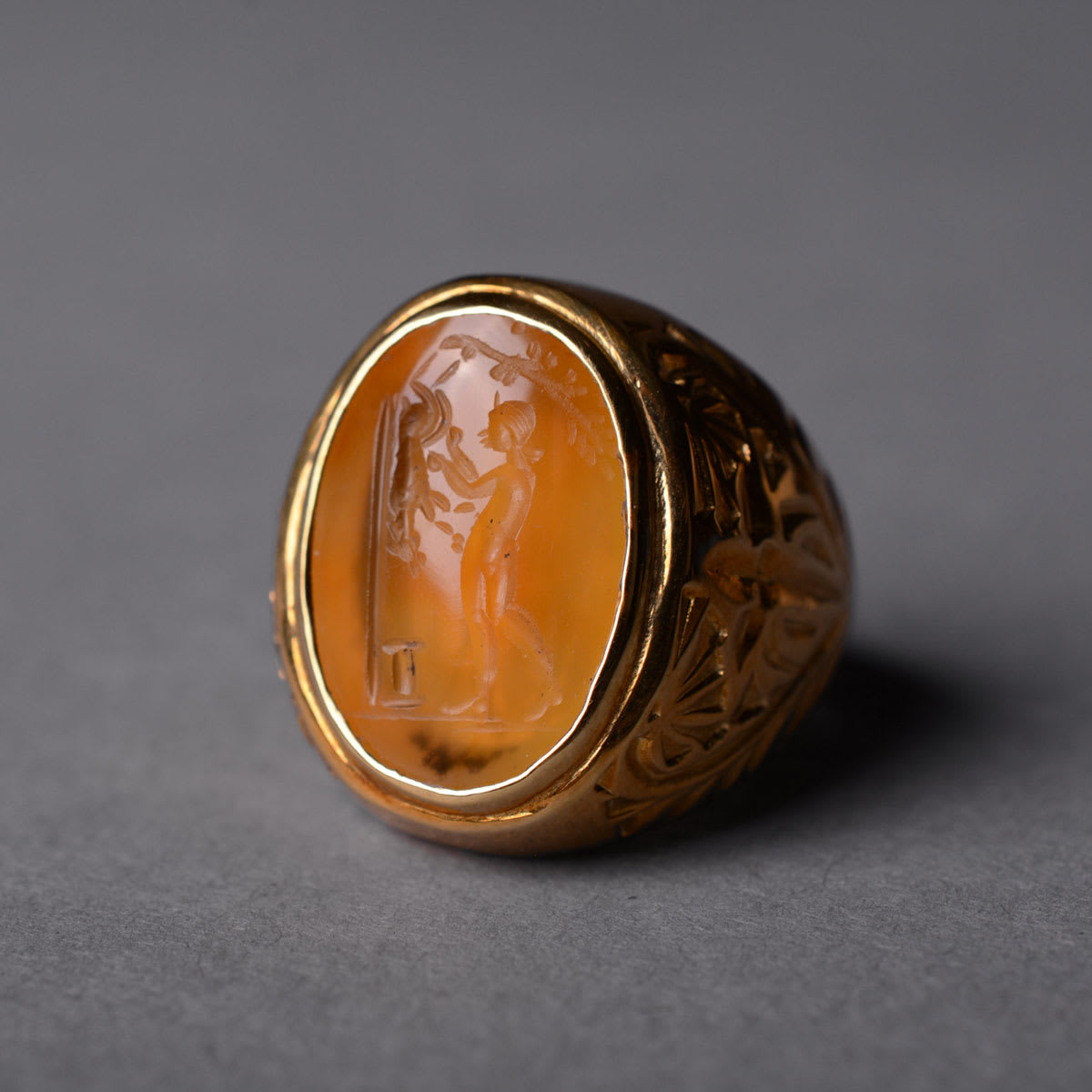Roman Carnelian Intaglio Depicting a Man Flaying an animal, 100 CE - 300 CE
Carnelian-Gold
FJ.6728
Further images
This Ancient Seal Has Been Set in a Modern 18 Karat Gold Ring. The art of glyptics, or carving images on colored precious stones, is probably one of the oldest...
This Ancient Seal Has Been Set in a Modern 18 Karat Gold Ring.
The art of glyptics, or carving images on colored precious stones, is probably one of the oldest known to humanity. Intaglios, gems with an incised design, were made as early as the fourth and third millennia B.C. in Mesopotamia and the Aegean Islands. They exhibit a virtuosity of execution that suggests an old and stable tradition rooted in the earliest centuries. The tools required for carving gems were simple: a wheel with a belt-drive and a set of drills. Abrasives were necessary since the minerals used were too hard for a metal edge. A special difficulty of engraving intaglios, aside from their miniature size, was that the master had to work with a mirror-image in mind.
An interesting scene has been engraved onto the face of this precious gemstone. A small animal has been hung from a tree by its hind legs. A man stands nearby as he begins to flay this creature, probably preparing it for a feast. Such a scene seems a bit bizarre to carve onto a stone, however, flaying frequently occurs in mythological tales, often as a punishment. Although we are sheltered from this act today as we buy prepackaged cuts of meat wrapped in plastic, surely flaying was a common part of food preparation in antiquity and thus a part of daily life. This intaglio demonstrates the absolute mastery of the Roman glyptic craftsmen. The level of detail and clarity is stunning considering the limited proportions of the polished surface of the gemstone and the difficulty carving such dense, hard material. Today set in a marvelous 18 Karat gold ring, this gorgeous piece of jewelry invokes the glories of Ancient Rome. Wearing this ring reveals a love for the past and for the timeless beauty of the Classics.
The art of glyptics, or carving images on colored precious stones, is probably one of the oldest known to humanity. Intaglios, gems with an incised design, were made as early as the fourth and third millennia B.C. in Mesopotamia and the Aegean Islands. They exhibit a virtuosity of execution that suggests an old and stable tradition rooted in the earliest centuries. The tools required for carving gems were simple: a wheel with a belt-drive and a set of drills. Abrasives were necessary since the minerals used were too hard for a metal edge. A special difficulty of engraving intaglios, aside from their miniature size, was that the master had to work with a mirror-image in mind.
An interesting scene has been engraved onto the face of this precious gemstone. A small animal has been hung from a tree by its hind legs. A man stands nearby as he begins to flay this creature, probably preparing it for a feast. Such a scene seems a bit bizarre to carve onto a stone, however, flaying frequently occurs in mythological tales, often as a punishment. Although we are sheltered from this act today as we buy prepackaged cuts of meat wrapped in plastic, surely flaying was a common part of food preparation in antiquity and thus a part of daily life. This intaglio demonstrates the absolute mastery of the Roman glyptic craftsmen. The level of detail and clarity is stunning considering the limited proportions of the polished surface of the gemstone and the difficulty carving such dense, hard material. Today set in a marvelous 18 Karat gold ring, this gorgeous piece of jewelry invokes the glories of Ancient Rome. Wearing this ring reveals a love for the past and for the timeless beauty of the Classics.







